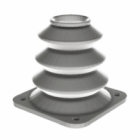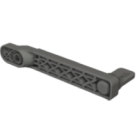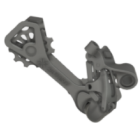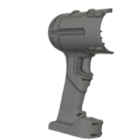Costs, time & practical considerations
How much does 3D printing really cost? How long does a print take? What are the hidden factors that affect budget, maintenance, and daily use? In this section, we address the practical side of 3D printing — from upfront investment and material expenses to workflow efficiency, failure rates, and machine upkeep. These FAQs will help you make informed, realistic decisions whether you’re buying your first printer or scaling up production.
Entry-level printers can cost a few hundred euros, while industrial systems like SLS can range from €10,000 to over €100,000. Price reflects build size, precision, material compatibility, and automation features.
The cost comes from high-end equipment, specialized materials, and post-processing needs. Industrial-grade printers and materials are engineered for performance, not mass-market pricing. However, costs are dropping as the technology matures.
The cost of a 3D printed part depends on material type, print time, machine usage, and post-processing. For FDM, costs can start as low as €1–2, while industrial SLS or metal prints may exceed €100 per piece. Software tools can help estimate material usage and electricity consumption for accurate quotes.
SLS printing costs vary based on material, part volume, and production scale. In-house printing reduces per-part cost over time, but initial investment in equipment can range from €10,000 to €100,000+. Outsourcing can range from €5 to €50+ per part.
It depends on your needs. If you frequently prototype, customize parts, or iterate on designs, owning a 3D printer can save time and cost. For hobbyists, designers, or small businesses, entry-level printers offer a strong return on investment. For industrial applications, in-house printing can reduce lead times and reliance on suppliers.
Energy use varies by printer type. SLS and resin printers typically consume more power than FDM due to lasers or heating systems, but overall usage is still modest compared to traditional manufacturing.
The time required to 3D print a part depends on several factors, including the size of the object, level of detail, chosen layer height, and the type of 3D printing technology. Small, low-detail models can be printed in under an hour, while larger or highly detailed parts may take several hours or even more than a day. FDM printers tend to be slower for detailed prints but efficient for basic shapes, whereas SLS and SLA can produce complex geometries faster, especially in batch production. Layer thickness also plays a key role — thinner layers improve quality but significantly increase print time. Planning ahead with optimized settings and realistic expectations is essential for managing production schedules.
In general, 3D printing can take anywhere from 30 minutes to over 24 hours, depending on the size, complexity, layer height, and printing technology used.
Print duration is affected by layer height, part size, complexity, infill density, and printer speed. High-detail prints with small layer heights take significantly longer. Smart orientation and optimized slicing can dramatically reduce build time. More about factors affecting print cost.
Post-processing improves surface finish, removes excess powder, and can enhance mechanical properties. It also affects the final look — from matte to polished finishes — and can be critical for tight tolerances. Proper post-processing makes parts look and perform more like end-use products.
Yes, depending on the technology, post-processing may include support removal, sanding, dyeing, curing, or polishing. It adds time and labor but improves surface finish, mechanical performance, and appearance. SLA and SLS prints typically need more post-processing than basic FDM parts.
Beyond material and machine costs, hidden expenses include maintenance, failed prints, calibration time, and labor for post-processing. Software licenses and workspace safety equipment (especially for resin or powder printers) can also add up. It’s important to factor these into your ROI calculations.
In-house printing offers lower long-term costs for frequent use and faster iteration. Outsourcing is ideal for low-volume or complex prints without the need for machine investment. The best option depends on your budget, capacity, and turnaround expectations.
Use optimized print settings such as lower infill, larger layer heights, and minimal supports. Select cost-effective materials like PLA or recycled filaments for prototypes. Efficient part orientation and combining multiple objects in one build also help reduce waste and time.
3D printing excels in short-run production and customization, especially when tooling costs for traditional manufacturing are too high. It enables just-in-time production, mass personalization, and design flexibility — all with reduced lead times and inventory risks.
Most desktop 3D printers consume relatively little power — typically between 50 and 250 watts while printing, similar to a standard light bulb or a laptop. Larger industrial machines, like SLS or DMLS systems, can require significantly more energy due to heated chambers, lasers, and processing systems. However, overall energy use is still often lower than traditional manufacturing methods for the same part. Efficiency depends on print time, materials, and printer type.
The cost of 3D printing materials varies widely depending on the technology and type of material used. Standard FDM filaments like PLA can cost as little as $20–30 per kilogram, while engineering-grade filaments or resins may reach $100 or more. SLS powders such as PA12 are typically more expensive than FDM filaments, with prices commonly ranging from $100 to $200 per kilogram. However, when purchased in larger volumes — especially from suppliers like Sinterit — the cost can drop significantly, often to as low as $50–$60 per kilogram. Post-processing and material waste can also affect total costs per part.
Explore also
- 3D printing basics explained
- Choosing the right 3D printing technology
- 3D printing materials guide
- Software & tools for 3D printing
- 3D printing market & capabilities
Related categories
 Austria
Austria  Bosnia and Herzegovina
Bosnia and Herzegovina  Bulgaria
Bulgaria  Croatia
Croatia  Czech Republic
Czech Republic  Denmark
Denmark  Estonia
Estonia  Finland
Finland  France
France  Germany
Germany  Greece
Greece  Hungary
Hungary  Ireland
Ireland  Italy
Italy  Latvia
Latvia  Lithuania
Lithuania  Poland
Poland  Portugal
Portugal  Romania
Romania  Slovakia
Slovakia  Slovenia
Slovenia  Spain
Spain  Sweden
Sweden  Switzerland
Switzerland  United Kingdom
United Kingdom  Ukraine
Ukraine  China
China  Hong Kong
Hong Kong  India
India  Israel
Israel  Japan
Japan  Malaysia
Malaysia  Philippines
Philippines  Saudi Arabia
Saudi Arabia  South Korea
South Korea  Taiwan
Taiwan  Thailand
Thailand  Turkey
Turkey  United Arab Emirates
United Arab Emirates  Egypt
Egypt  South Africa
South Africa  Tunisia
Tunisia  Canada
Canada  Mexico
Mexico  United States
United States  Brasil
Brasil  Colombia
Colombia  Australia
Australia  New Zealand
New Zealand 












